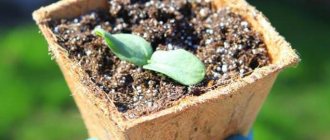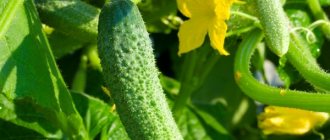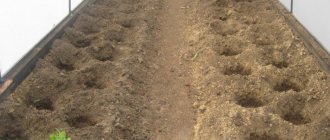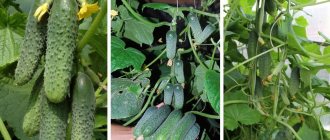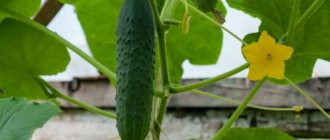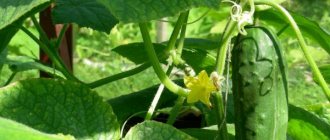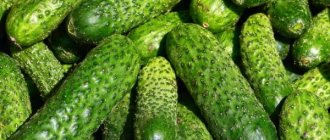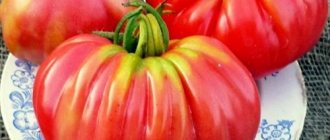Vegetable growing » Cucumbers
0
2187
Article rating
Kira Stoletova
The Pogrebok cucumber variety has a lot of positive characteristics and is easy to care for.
Characteristics of Pogrebok variety cucumbers
The fruits are universal, which makes it possible to grow a multi-purpose crop even in the smallest area. Thanks to these characteristics, the variety is in demand among gardeners.
Description and characteristics of the variety
Cellar f1 is a bee-pollinated hybrid, so during the flowering period it is necessary to ensure unhindered access to it by insects. It can be grown in temporary shelters under film or in open ground. It is resistant to disease and stress.
Characteristics of the bush: it is of indeterminate type. The first harvest ripens 43-48 days after germination. The length of the greens is 9-11 cm. The skin has slight white stripes and is dotted with large tubercles. The color of the thorns is brown or black. Fruit weight – 90-100 g.
Description of the fruit: cucumbers taste pleasant, the pulp is juicy and aromatic. They are good for pickling and canning, and are also suitable for fresh dishes.
How to properly and competently care for cucumbers in open ground
Knowing how to properly grow cucumbers in open ground and the basic requirements for their growing conditions, you can get an excellent harvest of greens. Agricultural care techniques include watering, loosening, fertilizing, proper formation (pinching of vines), and timely harvesting.
Features of watering
An important point in caring for cucumbers is watering, since the pumpkin crop is moisture-loving. If the soil is dry, the leaves quickly begin to wither. This is also due to the superficial location of the root system, which is not capable of extracting moisture from the deep layers of the soil.
When watering, the following points should be considered:
- use only warm, settled water:
- do not pour water under the root, retreating 5 cm;
- Do not water at night when the temperature drops.
Greens should not be overwatered: with excessive watering (especially in cool weather), root rot or powdery mildew develop. When using cold water, slow plant growth and shedding of ovaries are observed. After irrigation, the soil should be loosened and mulched.
Fertilizing rules
Let's figure out how to grow good and level cucumbers in open ground.
To do this, use fertilizing, which is carried out in 3 stages:
- 2 weeks after planting, nitrogen is added in the form of fermented mullein infusion (1:10). You can use ammonium nitrate (according to the instructions). This allows plants to increase their above-ground portion.
- Before flowering, phosphorus-potassium mixtures are added to the soil, aimed at the formation of ovaries.
- During the fruiting period, complex formulations are added. Mullein infusion, to which nitroammophoska is added (1 tablespoon per 10 liters of solution), has a good effect on the growth of greens.
During the growing season, organic fertilizers are useful and significantly increase productivity. Of the complex mineral fertilizers, ash is most often used.
On a note! At the beginning of growth or when it weakens, foliar fertilizing with a urea solution is carried out to increase green mass. If the leaves turn yellow, then the bushes can be treated with a soda solution (1 tbsp per 10 l).
Plant Formation
Planting and caring for cucumbers in open ground involves the formation of stems so that as many greens as possible form on them. The stem is pinched above the 5-6th leaf, which stimulates the growth of lateral shoots on which female flowers are formed. Hybrids are grown into a single stem, which forms the bulk of the ovaries.
They use the horizontal method, when the shoots spread along the ground, and the vertical cultivation of cucumbers in open ground, which provides significant advantages.
The advantages are as follows:
- saving space;
- greater harvest;
- lower risk of disease;
- increasing the growing season;
- more convenient care and harvesting of fruits.
For the pumpkin crop, a trellis is created along which the vines grow, clinging to the support with tendrils. With the vertical method of growing cucumbers in open ground, trellises of different designs are created: vertical or inclined rectangular, round in the form of a “tent,” wall-mounted, when a fence or wall acts as a support.
How to properly care for cucumbers on a trellis? It is necessary to monitor the growth of the plant, helping it “climb” onto the support. If a stretched twine is used, the lashes are twisted around it. With horizontal slats, the stems are reinforced with strips of fabric. If there is a net, the plant clings to it with its tendrils.
When forming lashes on a trellis, it is necessary to carry out the procedure of pinching the growth point of side shoots once every 7-10 days. In this case, you need to focus on the characteristics of a particular variety: on which vines female flowers are formed (information in the instructions on the label). How to form a pumpkin crop step by step is shown in the photo.
Landing
Seeds are sown for seedlings in April, and in the ground when the temperature reaches +15 and the threat of frost has passed.
The bed is selected on a hill, protected from wind and stagnant moisture. It is better if onions, cabbage, potatoes, tomatoes, peppers or legumes grew on it last season. Areas after cucumbers, zucchini and pumpkins, as well as melons, should be avoided.
Bee-pollinated hybrids should be placed away from parthenocarpic hybrids so that pollen does not mix.
The bed is dug up and fertilized in the fall. For 1 sq. m add at least a bucket of humus or compost. For 1 sq. m, 3 bushes are placed. When sowing the seeds of the variety in the ground, cover the bed with film until the sprouts appear.
Seedlings are grown in small pots in a sunny place. Its growth period is 25-30 days.
Harvesting
The first cucumbers ripen 1.5 months after germination. The fruits are a hybrid type of cylindrical shape, tapering towards the base, up to 11 cm long, up to 4 cm in diameter and weighing up to 100 g.
It is recommended to collect the fruits early in the morning, when they are the strongest and most elastic, carefully tearing them off the stem without damaging the fragile lashes. Cucumbers should not be allowed to overripe so as not to stop the fruit formation process. The more often you harvest, the more new ovaries will form on the plant.
The structure of the fruit, excellent taste and lack of bitterness determine the versatility of the Pogrebok variety and allow it to be used for preparing fresh salads and canning, while greens pickled in barrels have received the most positive reviews. Pickles and gherkins are more often used for pickling, and large fruits are used for barrel pickling. Strong vegetables tolerate transportation well.
Growing and care
The bushes are watered with warm water at a temperature of about +25. The optimal time is when the bushes are not exposed to sunlight, in the morning or evening. You need to water once every 2-3 days or daily in hot weather.
Feed moderately 2-3 times per season. Useful fertilizers:
- superphosphate;
- potassium nitrate;
- urea;
- ammophoska and nitrophoska;
- potassium sulfate;
- cow dung;
- chicken droppings.
The last two fertilizers are organic. They are diluted with water in a concentration no stronger than 1:10 and the bushes are watered. The rest of the preparations are mineral, take 10-20 g per bucket. You should not apply all the fertilizers at once; they are alternated and if there are symptoms of an overdose, stop feeding.
At least once a week, the soil is carefully loosened to provide oxygen to the roots.
The bushes are tied to supports.
Moorish lawn - how to care
1. Haircut - the first time the haircut is carried out before the flowers appear, then after the seeds ripen, while the optimal mowing height is from 8 to 10 cm. When there are bulbous crops on the lawn, the haircut is carried out after the leaves die, and if the lawn has perennial flowers, mow needed before perennials grow.
It is necessary to mow the lawn for the first time in June (at the end) or beginning of July, when the process of seeding of meadow flowers occurs; the Moorish lawn is mowed again at the end of October. It should be noted that this is an approximate order and if the lawn grows quickly, re-cutting will be required in August
2. Weeding - this will have to be done manually, so it is better to plant a Moorish lawn at the border of the site or in the form of a narrow strip near the fence
3. Watering - plays a huge role in the first couple of weeks after the completion of the sowing procedure, and watering in the form of small, careful sprinkling over several passes will help ensure optimal moisture supply to the first shoots. After seed germination, soil moisture must be maintained through artificial irrigation.
4. Fertilizing - in the first year of life of the Moorish lawn, fertilizers are not applied, this can be harmful; fertilizing is applied in the second year, if necessary, when the plants begin to turn yellow or wither. In this case, you need to scatter Nitroammofoska, ammonium nitrate or urea over the entire area in an amount of 10 to 20 g per 1 m². Then you should water the area to better dissolve the fertilizer.
5. Aeration – carried out to ensure gas exchange of intrasoil oxygen with external oxygen. The essence of this process is quite simple - you need to pierce the soil shallowly using a fan rake or fork
Resistance to diseases and pests
The hybrid successfully resists cladosporiosis, downy mildew, and other diseases. Fungi can attack it due to temperature changes and excess moisture.
To combat powdery mildew and white rot, bushes are sprayed with copper-containing fungicides. To prevent other diseases, it is enough to follow the rules of care.
Dangerous parasites include aphids, slugs, and spider mites.
Slugs
The perimeter of the bed and the foliage of plants are sprinkled with wood ash for protection. Sprinkling the soil with a mixture of red pepper and mustard is also effective.
Mite
Insecticides are used against it. These are Ethisso and Plant-Pin in the form of sticks (they are immersed in the soil near the root) or spraying with Aktara.
What is a Pogrebok cucumber?
According to reviews from summer residents and consumers, the main features of the variety include rapid fruit ripening, excellent yield, unpretentiousness, excellent taste, and long-lasting fruiting. Its excellent presentation and biological factors quickly made the hybrid variety popular among consumers and summer residents who grow cucumbers in their gardens.
Characteristics and description of the Pogrebok cucumber variety:
- The variety was created by domestic breeders and Pogrebok was recently included in the State Register of Breeding Achievements.
- This hybrid variety is early ripening.
- Created by scientists as a garden crop for growing in open ground and in greenhouses, which protect cucumbers from frost and frost.
- Under favorable conditions, the yield of the hybrid variety varies from 15 to 17 kg per plot of 1 m².
- Vegetables ripen within 43-48 days from the date of planting in the soil. Thus, after 1.5 months, summer residents receive their first harvest of cucumbers.
The hybrid variety is resistant to various diseases that affect vegetable and garden crops. This can be considered one of the most important achievements in the work of breeders. It is also worth noting that the variety is suitable for fresh consumption, in salads, for creating various twists, pickles, and preservation.
The technical parameters of the hybrid variety include:
- Indeterminateness.
- The bushes are called medium-branched.
- The vines on the bushes have shallow leaves.
- The type of flowering is mixed. Female flowers predominate and form on the branches. Most of the female flowers are on the side shoots.
- Downy mildew.
- Cladosporiosis.
- White rot.
- Melon aphid.
You can increase the immunity of plants if you properly care for the bushes and follow the planting rules. Firstly, the soil must be treated and fertilized with mineral and organic fertilizers before planting, which increases the flow of useful components into the soil and into the root system of the bushes.
It is not recommended to plant hybrid cucumbers on plots of land if beans and carrots previously grew on them. This can cause the spread of white rot. This is a disease that most often affects cucumbers. If signs of disease are found on the bushes, it is necessary to remove the affected leaves or sections of the stem. Then the leaves of the plants should be sprayed with a solution containing one of the preparations, which includes copper and its varieties.
Melon aphids can also be dealt with by spraying with a solution of ordinary laundry soap or with preparations such as Fufanon, Biotlin and their analogues.

